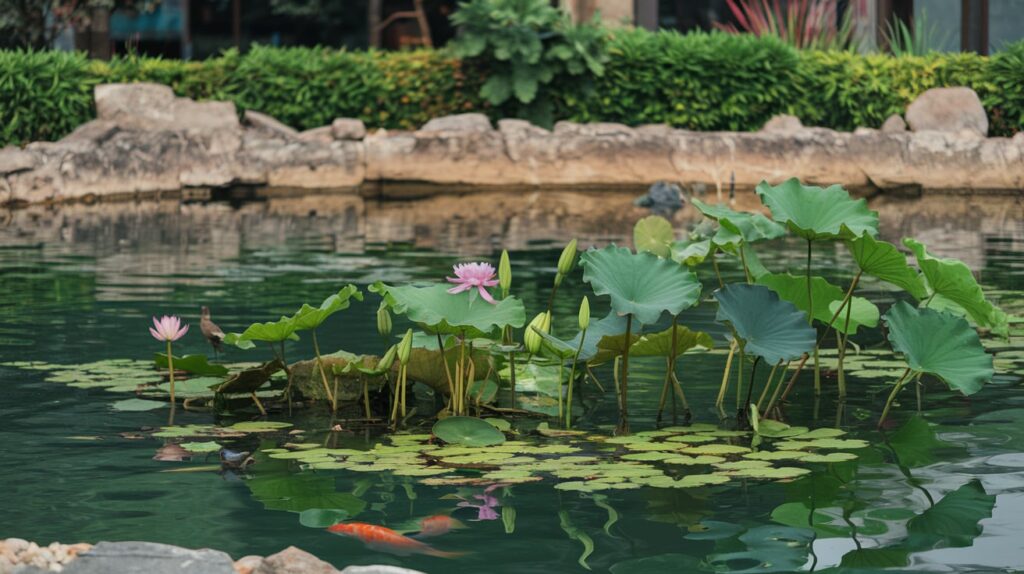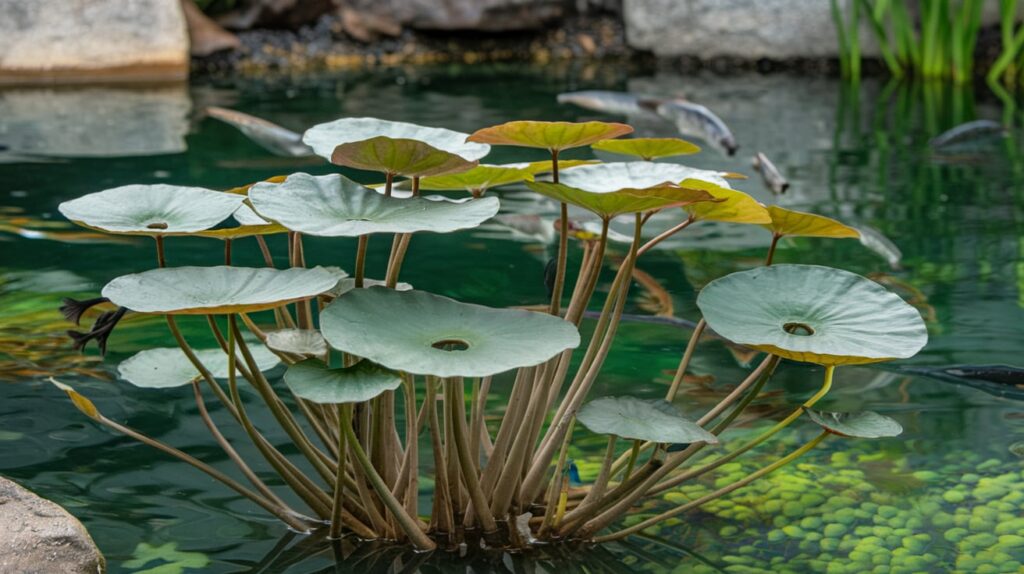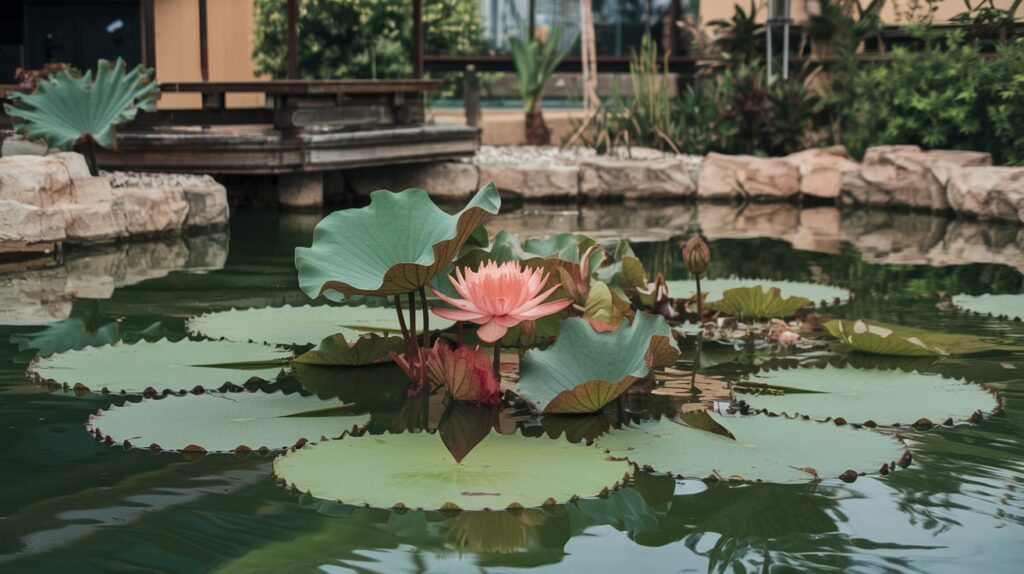Every pond keeper should be looking to create a vibrant and healthy fish pond. Today we will be covering the best types of plants for fish ponds, in which you will discover an array of plant choices that not only enhance the beauty of your pond but also contribute to the wellbeing of your aquatic friends.
From oxygenators to floating plants, we’ll cover the must-have varieties that provide natural filtration, shade, and a habitat for your fish, turning your pond into a thriving underwater ecosystem. Dive in and transform your fish pond today! Have you ever wondered what types of plants would thrive in your fish pond and enhance its beauty while keeping the water healthy? You’re not alone!

Many pond enthusiasts, just like you, seek the perfect balance of aesthetics and functionality when it comes to selecting plants for their fish ponds.
Choosing the right plants isn’t just about creating a pretty scene, though that’s a huge plus. The right aquatic plants can improve water quality, provide shade and protection for your fish, and even prevent algae growth. In this article, we’ll dive into the best types of plants for fish ponds, their benefits, how to care for them, and which ones might be the perfect fit for your pond sanctuary.
Why Are Pond Plants Important?
Enhancing Aesthetics
The first thing you may notice about pond plants is how they transform a simple water feature into a lush, vibrant ecosystem. They add a variety of shapes, colors, and textures that make your pond a stunning focal point in your garden.
Improving Water Quality
Many pond plants act as natural filters, cleaning the water by absorbing excess nutrients and pollutants. This not only keeps your pond crystal clear but also supports a healthier environment for your fish.
Providing Shelter
Plants offer essential shelter and breeding grounds for fish. They provide places for fish to hide from predators and to escape from the abrasive rays of the sun.
Reducing Algae Growth
Certain types of plants compete with algae for nutrients, effectively minimizing algal blooms and keeping your pond water clear and healthy.

Types of Pond Plants
When you’re planning your pond, it’s important to understand the different categories of pond plants. Each type serves unique roles and when used together, they create a balanced ecosystem. Let’s break them down one by one.
Floating Plants
Floating plants rest on the surface of the water and their roots dangle down into the water. These plants are excellent for providing shade and reducing algae growth.
Best Floating Plants
| Plant Name | Benefits | Care Tips |
|---|---|---|
| Water Hyacinth | Excellent at oxygenating water and absorbing excess nutrients. | Needs to be thinned regularly to prevent overgrowth. |
| Duckweed | Helps to control algae and provides fish with shade. | Can quickly cover the entire surface, so monitor growth. |
| Water Lettuce | Offers great shelter for fish and helps maintain water balance. | Needs to be kept in check to avoid complete coverage. |
Submerged Plants
These plants grow entirely underwater and are primarily responsible for oxygenating the water and providing shelter for small fish and aquatic creatures.
Best Submerged Plants
| Plant Name | Benefits | Care Tips |
|---|---|---|
| Anacharis | Oxygenates water and provides shelter. | Trim regularly to prevent it from becoming invasive. |
| Hornwort | Absorbs excess nutrients, reducing algae growth. | Fast-growing; keep it pruned. |
| Cabomba | Great oxygenator and offers hiding spots for fish. | Needs moderate light and might require CO2 supplementation. |
Marginal Plants
Marginal plants grow at the edge of the pond, partly submerged. They are effective at preventing soil erosion and adding depth to the pond’s aesthetic appeal.
Best Marginal Plants
| Plant Name | Benefits | Care Tips |
|---|---|---|
| Cattails | Excellent at absorbing nutrients and providing tall, graceful structures. | Give them ample space as they can spread rapidly. |
| Pickerelweed | Produces beautiful blue flowers and helps stabilize pond margins. | Prefers full sun to partial shade. |
| Iris | Adds vibrant colors and texture to the pond edges. | Plant them in shallow water for best results. |
Emergent Plants
Emergent plants have roots anchored at the bottom of the pond, but their stems and leaves rise above the water surface. They are crucial for providing shade and habitats for various aquatic life forms.
Best Emergent Plants
| Plant Name | Benefits | Care Tips |
|---|---|---|
| Lotus | Adds a touch of exotic beauty with large, colorful blooms. | Needs full sun and space to spread out. |
| Water Lilies | Offers shade, reduces water temperature, and improves overall pond aesthetics. | Plant in containers to control spreading and fertilize regularly. |
| Papyrus | Adds height and striking visual interest to your pond. | Needs plenty of water and can be planted in shallow areas or containers. |
Selecting Plants for Fish Ponds
When choosing plants for your fish pond, consider the local climate, the size of your pond, and the specific needs of your fish. Here are some guidelines to help you make the best choices:
Climate Considerations
Some plants are more tolerant of cold weather, while others thrive in tropical climates. Ensure you pick plants that are compatible with your local weather conditions.
Pond Size
Balance is key. Too many plants can overwhelm a small pond, while too few may not provide the desired benefits. Consider your pond’s size and the growth habits of your chosen plants.
Fish Compatibility
Certain fish might nibble on your plants, while others might require more hiding spots. Understand your fish’s behavior and select plants that can coexist harmoniously.
Maintenance
All plants require some level of maintenance, but the degree can vary. Ensure you’re prepared for the upkeep required to keep your pond flourishing.

Plant Care and Maintenance Tips
Keeping your pond plants healthy requires more than just planting them and hoping for the best. Here are some general care tips to ensure your aquatic garden thrives:
Regular Trimming
Keep your plants neat by trimming back excess growth. This prevents them from becoming invasive and ensures they have room to breathe.
Monitor Water Quality
Regularly test the water’s pH, ammonia, nitrite, and nitrate levels. Healthy water makes for healthy plants and fish.
Fertilize as Needed
Some aquatic plants may need additional nutrients. Use aquatic plant fertilizers to provide the necessary nourishment without harming your fish.
Prevent Pests
Watch for signs of pests or diseases, such as discolored leaves or slow growth. Promptly address any issues to keep your plants in tip-top shape.
Creating a Balanced Ecosystem
Achieving a balanced ecosystem in your fish pond involves integrating various types of plants and ensuring each one plays its part. Here’s how you can create a thriving, balanced pond:
Mix and Match
Use a combination of floating, submerged, marginal, and emergent plants to create a diverse, functional ecosystem.
Introduce Gradually
Introduce plants gradually to see how they adapt to your pond. This step-by-step approach helps prevent any sudden imbalances in your pond’s environment.
Monitor Growth
Keep an eye on how your plants are growing and their impact on water quality. Remove any unhealthy plants and replace them as necessary.
Seasonal Adjustments
Adjust your plant care routine with the changing seasons. Some plants may need extra care during winter months, while others might thrive during the summer.
Benefits of Natural Filtration
One of the biggest advantages of using plants in your fish pond is the natural filtration they provide. Let’s look deeper into how this works:
How Plants Filter Water
Plants act as natural filters by absorbing excess nutrients and pollutants from the water. Their root systems also offer surfaces for beneficial bacteria to colonize.
Reducing the Need for Mechanical Filters
With the right balance of plants, you can significantly reduce your reliance on mechanical filters. This not only saves energy but also ensures a more natural and tranquil pond environment.
Improving Fish Health
Naturally filtered water is healthier for fish, reducing stress and the likelihood of diseases. Healthy plants support healthy fish, creating a harmonious ecosystem.
The Role of Plants in Pond Ecosystems
Plants play multiple crucial roles in maintaining a balanced pond ecosystem. Let’s delve into these roles:
Oxygen Production
Photosynthesis in aquatic plants releases oxygen into the water, crucial for the survival of fish and other aquatic life.
Providing Shelter and Breeding Grounds
Plants offer essential cover for fish to hide and escape from predators, as well as ideal spots for laying eggs.
Nutrient Absorption
Aquatic plants absorb nutrients from fish waste and decaying organic matter, preventing these substances from promoting algae growth.
Algae Control
Certain plants, through their nutrient absorption and shading, can outcompete algae, keeping your pond clear and aesthetically pleasing.
Aesthetic Value of Pond Plants
While functional benefits are vital, the aesthetic value of pond plants can’t be overlooked. The right selection of plants can turn an ordinary pond into a breathtaking water garden.
Color and Texture
Aquatic plants come in a range of colors and textures. Combining different types can create a dynamic visual landscape that changes with the seasons.
Seasonal Interest
By selecting a variety of plants that bloom at different times of the year, you ensure year-round interest and beauty in your pond.
Creating Focal Points
Certain plants like water lilies or lotus can serve as stunning focal points, drawing attention and creating a sense of serenity and peace.

Common Challenges and Solutions
As with any garden, maintaining a pond comes with its own set of challenges. Here are some common issues and practical solutions:
Overgrowth
Plants like water hyacinth and duckweed can grow rapidly, covering the pond surface.
Solution: Regularly trim and thin out these plants to maintain a balanced environment.
Algae Blooms
Excessive nutrients can lead to algae blooms, turning your clear pond water green.
Solution: Introduce more nutrient-absorbing plants and monitor feeding practices to avoid overfeeding fish.
Pest Infestations
Aquatic plants can be susceptible to pests and diseases, affecting their growth and health.
Solution: Introduce natural predators or use environmentally safe pest control methods.
Winter Care
Cold weather can be tough on some pond plants.
Solution: Move sensitive plants to deeper water or cover your pond to protect them from frost.
Expert Tips for Maximizing Plant Health
Let’s explore some expert tips to ensure your pond plants thrive:
Choose Native Plants
Native plants are adapted to your local climate and soil conditions, making them easier to care for and more likely to thrive.
Use Plant Baskets
Plant baskets or containers can help control invasive species and make it easier to manage your pond plants.
Monitor Light Levels
Different plants have varying light requirements. Ensure each plant gets the right amount of sunlight to thrive.
Balance Fish and Plants
Maintain a balanced ratio of fish to plants. Too many fish can lead to excessive nutrients, while too few plants can’t absorb all the nutrients, leading to algae growth.
Conclusion: Best Types Of Plants For Fish Ponds
Creating a beautiful and functional fish pond is an enjoyable and rewarding endeavor. By selecting the best types of plants for your fish pond and understanding their needs, you can create a thriving ecosystem that’s both visually stunning and beneficial for your fish.
Remember to mix and match plant types for a balanced environment, monitor growth and water quality, and adjust your care routine with the changing seasons. With a bit of effort and attention, your pond can become a lush, vibrant sanctuary that provides endless enjoyment and tranquility.
Feel free to experiment and adapt these guidelines to fit your unique pond environment. Happy pond gardening!
